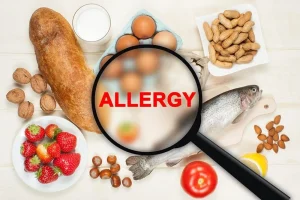Fruit allergies are not as common as other food allergies, but they can still have a major impact on a person’s quality of life. To successfully deal with fruit allergies, people must fully understand the allergens involved, recognize the symptoms, and have a plan to avoid exposure. This article discusses helpful ways to deal with fruit allergies so that people with fruit allergies can live healthier and safer lives.
1. Understanding Fruit Allergies
When someone is allergic to fruit, the immune system thinks the proteins in that fruit are harmful, causing an allergic reaction. These reactions may be accompanied by a variety of symptoms, which can be mild or severe. Apples, bananas, strawberries, kiwis, and melons are all foods that can cause allergies. Oral allergy syndrome (OAS) and broader food allergies are the two main types of fruit allergies commonly found in humans. Pollen allergy can cause oral allergy syndrome, also known as pollen-food syndrome. It has to do with a reaction to tree, grass, or weed pollen. People who are allergic to pollen may also be allergic to foods that contain similar proteins. On the other hand, a generalized fruit allergy can cause a more severe reaction that affects many parts of the body. Symptoms can include hives, stomach pain, or even an allergic reaction, a life-threatening reaction that requires immediate medical attention.
2. Diagnosing Fruit Allergies
To successfully treat fruit allergies, it is important to make an accurate diagnosis. If you think you have a fruit allergy, call your doctor or ask about allergens. They can perform several tests to look for individual allergens, such as:
Skin prick test: There is a skin prick test in which a small amount of the allergen is placed on the skin and then pricked to let the allergen in. If you get a bump or reaction, you have an allergy.
Blood test: Checks the amount of specific antibodies (IgE) produced in the blood when exposed to an allergen.
Oral food challenge: This test is performed in the presence of a doctor and involves eating increasing amounts of the suspected allergen to see if allergic reactions occur.
3. Avoiding Allergens
Staying away from known allergens is the best way to deal with fruit allergies. To do this, read food labels carefully to understand cross-reactivity and where allergens in prepared foods come from that you may not have known existed. For example, people who are allergic to bananas may also want to stay away from avocados and kiwis because their protein structures are similar. m Read the labels of the foods you buy and look for allergy warnings. Be aware of cross-contamination, especially when handling food produced in locations where other allergens are present.
4. Education and Communication
It is important to educate people with this disease, as well as their families, friends, and those who care for them. Everyone should be aware of allergies, what symptoms to look out for, and what to do if you have an allergic reaction. This is very important for children because they need to understand what is going on and learn how to stand up for themselves. It is important to provide schools, daycare centers, and other healthcare providers with a written action plan that explains your child’s allergies and symptoms and what to do if an allergic reaction occurs. Regular education and conversations can ensure that everyone is prepared to deal with allergies.
5. Be Prepared for Emergencies
For people with fruit allergies, it’s important to have a backup plan. This means you will need to carry prescription medications such as antihistamines and epinephrine auto-injectors. Make sure the person and anyone helping them know how to use the auto-injector correctly and know what to do in an emergency. If someone has a severe allergic reaction, especially anaphylaxis, he or she should immediately use an epinephrine auto-injector and call 911 for help. If you are not sure what to do, it is better to use epinephrine, as waiting can cause bigger problems.
6. Manage Your Diet
To maintain a healthy diet, managing fruit allergies also means finding fruits that are safe to eat, rather than fruits that cause allergies. Talking to a chef can help you create a meal plan that is healthy and allergen-free. Many non-allergenic foods can provide the same health benefits. For example, if a child is allergic to apples, he or she may be able to eat pears or grapes. Trying a variety of different safe vegetables can help you maintain a healthy, varied diet.
Conclusion
To successfully deal with fruit allergies, you need to understand the causes of fruit allergies, stay away from them, educate the people around you, and be prepared for emergencies. Parents and individuals can take steps to keep their children safe and healthy by understanding the causes and signs of fruit allergies. If given the right help and advice, people with fruit allergies can live healthy, active lives with few allergic reactions. Be sure to ask your doctor or nurse for personalized information and help on how to best manage a fruit allergy.
FAQs
1. What should I do if my child is allergic to fruit?
If the reaction is mild, stop eating the food you think is the allergen and take an over-the-counter antihistamine. If you have a severe reaction, especially if you show signs of anaphylaxis, use an epinephrine auto-injector (if you have been prescribed an epinephrine auto-injector) and call 911 immediately.
2. What can I do to prevent my home from becoming polluted?
To prevent allergenic fruits from mixing with other foods, store them separately, use separate utensils for preparing allergenic and non-allergenic foods, and clean surfaces after preparing allergenic foods.
3. How do I ensure that my child does not eat fruit at school that will make him or her sick?
Tell school staff about your child’s allergies, give them a written action plan, and make sure they have access to emergency medication. Teach your child about his allergies and how to speak up for himself and recognize symptoms.
4. Are there any non-allergenic foods?
Yes, there are plenty of vegetables that may not bother people with allergies but are still good for you. Talking to a nutritionist can help you make safe choices and create a healthy eating plan.
5. What should be on food labels?
When reading food labels, look for specific fruit allergens and look for cross-contamination warnings, such as “May contain” or “Processed in a concurrent processing facility.” Read more about the different types of allergens and their names.
6. Is there a way to treat fruit allergies?
There is currently no solution for fruit allergies. Avoiding known allergens, preparing for treatment responses, and working with healthcare professionals to closely monitor and treat the condition are all part of treatment.




